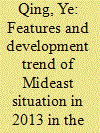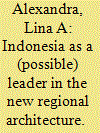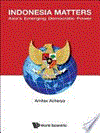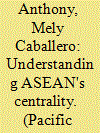|
|
|
Sort Order |
|
|
|
Items / Page
|
|
|
|
|
|
|
| Srl | Item |
| 1 |
ID:
128329


|
|
|
|
|
| Publication |
2013.
|
| Summary/Abstract |
The situation in Middle East is full of twists and turns in 2013, demonstrating a transitional character of the transformation of regional architecture. It has projected a certain extent of inheritance on the one hand and some tendencies for future development on the other. The adjustment of Mideast regional architecture will be shaped in the process of continuous rivalry between the new and old forces, the mutual adaptation of new and old modes and constant interaction between big powers and regional countries.
|
|
|
|
|
|
|
|
|
|
|
|
|
|
|
|
| 2 |
ID:
125251


|
|
|
|
|
| Publication |
2013.
|
| Summary/Abstract |
In the past five year, discussions on the possibility for Indonesia to regain leadership have taken place both at the regional and international arena. As many leadership praised Indonesia for its relatively fast economic rebound and ability to maintain its annual economic growth around 65, its membership in the prestigious economic grouping G20, its settle internal conflicts (peace settlement with free Aceh Movement is an imminent example), as well as various initiatives to shaping the new regional architecture have been portrayed by many analysts and policymakers as indicators of Indonesia`s rising status as a middle power country. While the path towards becoming a middle power is naturally developed as a country`s economic, Military and political power increase, the notion of "leadership" needs additional factors. This paper seeks to analyze whether it is possible for Indonesia to become a leader in the region; or, at least, whether it has the potentials to lead. The first section examines how to Indonesian government expressed the idea of leadership. The third section focuses particularly on the level acceptance from different countries, both within the country as well as immediate and far neighboring countries should Indonesia wish to pursue its track to become leader in the region.
|
|
|
|
|
|
|
|
|
|
|
|
|
|
|
|
| 3 |
ID:
155558


|
|
|
|
|
| Publication |
New Jersey, World Scientific, 2015.
|
| Description |
xii, 136p.pbk
|
| Standard Number |
9789814619851
|
|
|
|
|
|
|
|
|
|
|
|
Copies: C:1/I:0,R:0,Q:0
Circulation
| Accession# | Call# | Current Location | Status | Policy | Location |
| 059214 | 327.598/ACH 059214 | Main | On Shelf | General | |
|
|
|
|
| 4 |
ID:
087929


|
|
|
|
|
| Publication |
2009.
|
| Summary/Abstract |
Long a focal point in the study of Geography, regions have become a major concern of International Relations, and for some even its essence. Principle definitions and approaches, however, remain contested, as do the contexts in which and how they matter, from economic to security. This article examines contested views on what constitutes a region and on the nature and functioning of regional architecture, drawing from thematic and case-specific literature to indicate the expanse of analytical enquiry. These include the roles and interpretations of geography, identity, culture, institutionalisation, and the role of actors, including a hegemon, major regional powers and others actors from within a region, both state and societal. A final section indicates additional areas for future research.
|
|
|
|
|
|
|
|
|
|
|
|
|
|
|
|
| 5 |
ID:
147754


|
|
|
|
|
| Summary/Abstract |
AT PRESENT, the Asia-Pacific Region shows highly dynamic development rates, confidently asserting itself as a global economic engine and increasing its weight also in the political sphere. Obviously, the role of the Asia-Pacific Region in building a global polycentric architecture will continue to grow.
|
|
|
|
|
|
|
|
|
|
|
|
|
|
|
|
| 6 |
ID:
132402


|
|
|
|
|
| Publication |
2014.
|
| Summary/Abstract |
There have been a number of articles about ASEAN's centrality in the regional security architecture of Asia. Yet, the notion of centrality remains undefined and under-operationalised. Implicit in the discourses of centrality is the idea of ASEAN's leadership, which in turn raises questions about ASEAN's ability to do so, given its limited capacity. This article defines ASEAN's centrality from the perspective of social network approach and argues that ASEAN's structural position in the density of networks that it has established and those that it has linkages with explains ASEAN's centrality. Despite its lack of material power, ASEAN has been able to claim centrality because of its position as a node in a cluster of networks, and this condition of 'high betweenness' allows ASEAN to exercise influence in regional processes with the tacit acceptance of major powers. However, while centrality may have been achieved, maintaining centrality in a rapidly changing regional environment compels ASEAN to address challenges to its centrality. This would necessarily include its ability to maintain consensus, carry out collective action and achieve its stated goals.
|
|
|
|
|
|
|
|
|
|
|
|
|
|
|
|
|
|
|
|
|